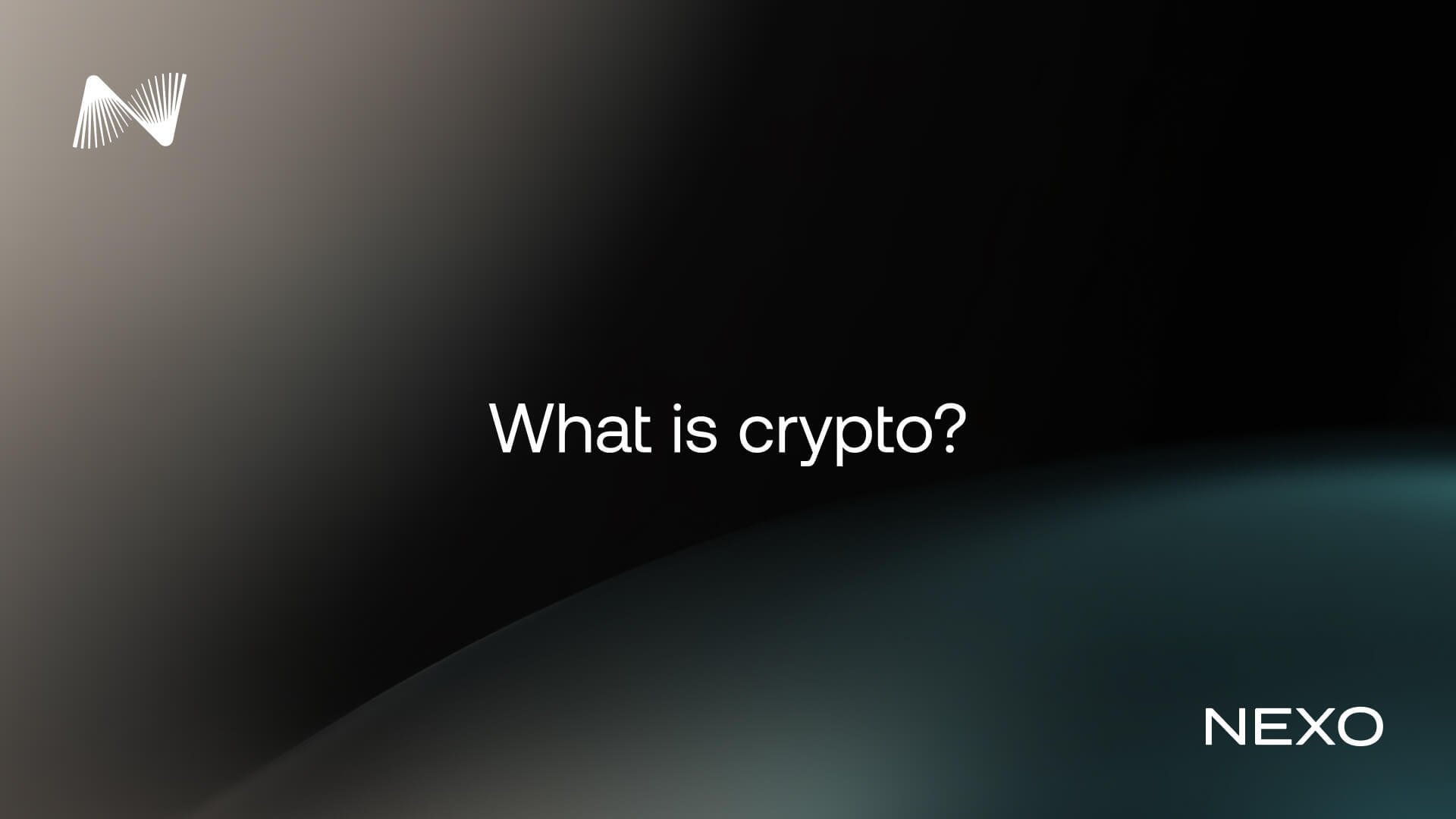What is crypto?
Feb 18, 2025•5 min read

Crypto, short for cryptocurrency, refers to digital assets that use cryptographic techniques to secure transactions, control the creation of new units, and operate independently of centralized authorities. These assets typically run on blockchain networks, where transactions are recorded transparently and permanently.
Cryptocurrencies can be used for transferring value, accessing decentralized applications, or participating in blockchain-based financial systems. They offer global, permissionless access to financial tools and are traded and stored digitally using crypto wallets.
What is cryptocurrency
A cryptocurrency is a digital form of money that exists only in electronic format. It is secured by cryptography and maintained by a decentralized network of computers, making it resistant to censorship, fraud, and double-spending.
Unlike traditional fiat currencies such as the U.S dollar, most cryptocurrencies have a fixed or algorithmically controlled supply. They are not issued by central banks or governments but by the rules coded into their blockchain protocols.
How does crypto work
Crypto works by combining several technologies:
Blockchain: A decentralized ledger that records all transactions across a network.
Public and private keys: Used to authorize and secure transactions.
Consensus mechanisms: Allow distributed systems to agree on the state of the blockchain (e.g., proof-of-work or proof-of-stake).
When someone sends crypto, the transaction is validated by the network and added to the blockchain. This structure allows users to exchange value securely without intermediaries.
What is crypto mining
Crypto mining is the process of validating transactions and adding new blocks to a blockchain. In proof-of-work systems like Bitcoin, miners solve complex mathematical problems using specialized hardware. The first to solve it gets to add the block and is rewarded with new cryptocurrency.
Mining helps secure the network and maintain consensus across all nodes.
How does crypto mining work
Crypto mining works through the following steps:
Transactions are broadcast to the network.
Miners group them into blocks.
Each miner competes to solve a cryptographic puzzle.
The winning miner adds the block to the blockchain.
The network verifies the block, and the miner receives a reward.
The process requires energy, computing power, and network connectivity. Over time, mining difficulty adjusts to maintain predictable block times.
How to mine crypto
To mine crypto, users typically need:
Specialized hardware: For example, ASICs or GPUs, depending on the asset.
Mining software: To connect with the network.
Reliable power: Mining consumes electricity continuously.
Most users now mine via mining pools, where resources are combined and rewards are shared. Alternatively, some blockchains use proof-of-stake, where mining is replaced by staking.
What is staking in crypto
Staking is the process of locking up cryptocurrency in a blockchain network to support its operations, such as validating transactions and securing the protocol. It is commonly used in proof-of-stake systems like Ethereum, where participants contribute their holdings to help maintain network integrity and participate in governance.
Staking is commonly associated with proof-of-stake blockchains, where validators are chosen based on the amount of crypto they stake and other factors, instead of using computational power like mining.
Stakers are typically rewarded with additional tokens, making it a way to earn passive income while supporting the network.
What is crypto staking
Crypto staking involves participating in a blockchain network by holding and committing coins for a set period. It supports the network’s security and transaction processing. The more you stake, the more weight your validation power carries.
Staking can take place directly on-chain or through supported platforms. The requirements and outcomes vary based on the asset and network.
How to buy crypto
Buying crypto typically involves the following steps:
Choose a platform that fits your needs. You can do this directly through the Nexo platform, where you can: – Purchase crypto using a card, bank transfer, or digital asset balance – Manage a variety of assets from a single account – Schedule automatic crypto purchases, so you can regularly add new digital assets to your portfolio.
Create an account and complete identity verification.
Add funds using your preferred method, such as a bank transfer, debit/credit card, or crypto transfer.
Select the cryptocurrency you want to buy and place an order.
Secure your assets by storing them in a platform-integrated or personal crypto wallet, depending on your preferences.
Please note: Availability of services on the Nexo platform is subject to local regulations and eligibility.
How to invest in crypto
There are several approaches to engaging with crypto:
Acquire and hold assets over time
Diversify across multiple cryptocurrencies
Use recurring purchases to reduce market timing risk
Research project fundamentals before committing funds
Due to market volatility, it’s important to evaluate your financial goals and risk tolerance before participating. Crypto markets operate 24/7 and can change rapidly.
What is crypto trading
Crypto trading involves buying and selling cryptocurrencies in order to take advantage of price movements. Traders may operate over minutes (day trading), hours (swing trading), or long-term cycles.
Trading requires access to a platform, market data, and basic technical or fundamental analysis tools. Liquidity and volatility are key features of crypto markets, which can offer both opportunity and risk.
How to trade crypto
To trade crypto effectively:
Choose a trading platform that suits your strategy.
Fund your account with crypto or fiat.
Analyze the market using available tools.
Place buy or sell orders manually or via automated options.
Monitor performance and manage risk.
New users may start with basic spot trading before exploring more advanced options.
What is slippage in crypto
Slippage in crypto refers to the difference between the expected price of a trade and the actual executed price. It typically occurs in volatile markets or when trading large volumes relative to market liquidity.
High slippage can lead to less favorable outcomes, especially in fast-moving or illiquid markets. To reduce slippage, traders often use limit orders or trade during high-volume periods.
Here’s a simple example:
Imagine you want to buy Bitcoin at $30,000. Just a few seconds after your order is processed, the price jumps to $30,150. That $150 difference is slippage. You ended up paying more than expected.
Slippage can work the other way, too, but either direction means you’re not getting the exact price you aimed for. To reduce slippage, experienced users often trade when markets are busiest or use limit orders, which only execute at a price you set in advance.
What is liquidity in crypto
Liquidity in crypto describes how easily an asset can be bought or sold without significantly affecting its price. Highly liquid markets have many participants and tight spreads, allowing for smoother trading.
Liquidity matters because it influences execution speed, slippage, and overall market stability. Assets with low liquidity may experience larger price swings and longer transaction times.
Let’s say you want to buy $1,000 worth of Bitcoin. On a highly liquid exchange like Nexo or Binance, there are thousands of other users placing buy and sell orders around the current market price. Your trade goes through instantly at or very close to the price you see — say, $30,000 per BTC. That’s high liquidity.
Now imagine you’re trying to buy a lesser-known token with fewer active traders. Your $1,000 order might push the price up because there aren’t enough sellers at your target price. Instead of paying $1.00 per token, you might end up paying $1.10 or more. That’s low liquidity in action, and it often leads to higher slippage and slower execution.
